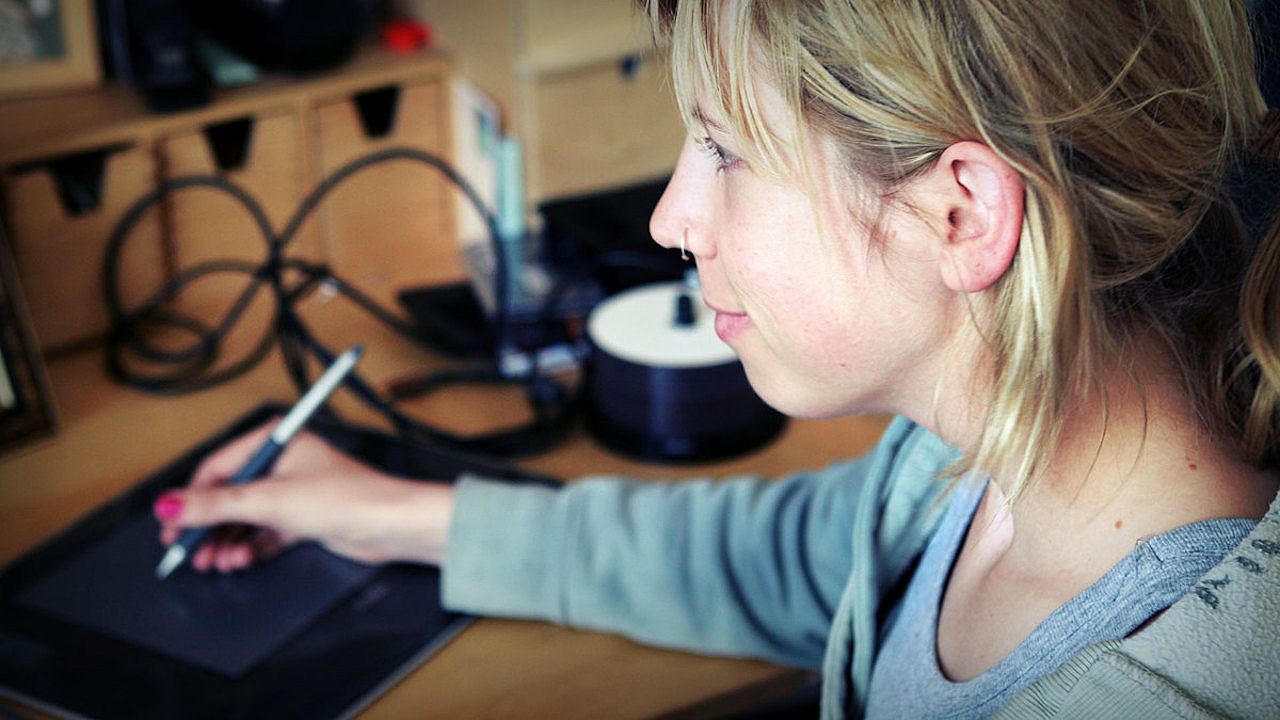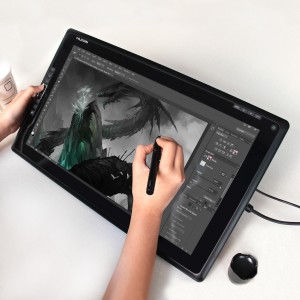Big Idea: Digital Tablets
Jun 9th 2016

📢 Post updated August 2024!
Tablet vs Mouse
New digital artists often ask the question, "Why get a tablet when I have a mouse?" Perhaps tablets give the impression of being a luxury rather than a necessity. And depending on your interests, a tablet can be a luxury or a necessity.
Who is the tablet for?
Tablets are most useful for certain disciplines: Digital painting, 3D modeling, 3D sculpting, and texture painting are the obvious candidates for a tablet. In fact, for those I would say a tablet is necessary. For other disciplines like rigging, animation, dynamics, and compositing, a digital tablet isn't as much of a necessity. Having said that, I've known riggers and animators who use a tablet exclusively. I've also known modelers who use a mouse exclusively. So we're not really talking about a right or wrong here. A tablet can be for anyone who wants to interface with the computer in a more natural, pencil-and-paper kind of way. Even though there's subjectivity involved in choosing a tablet or mouse, there are some objective benefits of a tablet over a mouse:
- Pressure Sensitivity: Tablets offer the ability to alter input based on the pressure of the pen against the tablet surface. This functionality has tremendous benefit when blending gradients in a painting or carving in digital clay; something a mouse cannot do.
- Tilt Sensitivity: Some tablets recognize the tilt of your pen to enable additional functionality that can't be emulated by a mouse. Think of when an sketch artist tilts a pencil to use the length of the tip for shading.
- Carpal Tunnel Prevention: While tablets aren't a cure for carpal tunnel, it does provide a more natural movement than a mouse. But the task variety of switching between keyboard, mouse, and tablet is beneficial for preventing carpal tunnel syndrome.
Kinds of Tablets
Of course there's a variety of choices in the world of digital tablets, as with anything. Some choices are simpler and budget-friendly while others offer the fanciest features and immersive interaction to make for the best artistic experience. Let's take a look at 3 tablet "classes".
CLASS 1: Tablet
"Intuos" by Wacom
This is the baseline class featuring a standalone tablet that offers no-look pencil-to-paper interaction. By "no-look", I mean the hand-eye coordination is like that of a mouse where you're looking at a computer monitor to see the result of your hand movement while your hand is actually moving out of sight. This kind of coordination can take some getting used to at first. But this class is the most affordable. The "Intuos" line fro Wacom is one of the most popular standalone tablets.
This is a good entry-level tablet class for digital artists who want the baseline benefits of a tablet. They're great for 3D modelers and sculptors.
CLASS 2: Tablet + Display
"GT-185" by Huion
This class eliminates the hand-eye coordination problem by making the tablet surface a computer monitor itself. So it's like drawing "on" a digital canvas, making for a much more natural interactive experience for digital artistry. Some consider it to be a negative of this approach that your arm covers a portion of the screen as you work - Traditional drawing and painting have the same problem. Brings back memories of graphite palm from my school years...The "Cintiq" is one of the most popular display tablets.
These are expensive tablets that are great for committed/professional digital painters and sculptors.
CLASS 3: Tablet + Display + PC
"Surface Pro" by Microsoft
This class offers the full package of being a tablet and display and computer. It's like having a digital drawing notebook in your backpack anywhere you go. As you can imagine, tablets like this are expensive. But they're growing in popularity thanks to an expanded manufacturer pool including Apple and Microsoft.
Brands
There are many companies offering tablets, but here's a few key players.
- Wacom - Leading tablet manufacturer offering all 3 classes. They've been around the longest, offering decades of reliable hardware and software, and tend to be the most expensive in each category.
- Huion - Quality manufacturer offering all 3 classes.
- XP Pen - Budget tablet manufacturer of class 1 and 2 tablets with an Android-based option for class 3.
- Gaomon - Budget tablet manufacturer of class 1 and 2 tablets with an Android-based option for class 3.
- Apple - iPad Pros qualifies as a class 3 tablet with a highly-praised user experience. However it should be noted that the iPad Pro runs iOS and AppStore apps instead of a desktop OS, meaning Blender is currently unavailable.
- Microsoft - Not to be outdone by the competition, Microsoft too has entered the tablet market with their class 3 Surface Pro.
What We Use
"I currently have a refurbished Intuos Pen & Touch model from Wacom. Before, I used a Bamboo Fun ($80 back in the day) that lasted 8 years and never stopped working. Moral of the history: Wacom is a quality brand and I get along fine with class 1 tablets." - Kent Trammell"I've used three tablets, all Wacom brand. I started with an old hand-me-down Intuos 1 or 2 (I don't remember which). After a few years of fiddling with it I upgraded to a Intuos 4 Medium, which is the tablet I still use today. For a while I added a 13in Cintiq but ended up selling it as I was no longer sculpting every day and preferred the ease of which the Intuos 4 could be slipped into my backpack." - Jonathan Williamson"I really enjoy using my Medium Intuos Pro when I'm working at my desk, but I've been using my Surface Pro a lot more because it's so portable. It has a solid drawing experience and can run full desktop apps like Photoshop and Blender, which makes it much more useful than a normal tablet or a normal laptop." -Jonathan Lampel"While I was in college I owned a Bamboo and since then have owned a Wacom Intuos 3 and 4, a Cintiq 13HD, and most recently a 22 Cintiq Touch. Based on my experience, I believe that all tablets function in a very similar fashion it just comes down to personal preferences. These can include the grip feel of the pen, the surface of the tablet (glossy or matte), the buttons available on the tablet, or even the most obvious preference: the size. I've found that working with a larger size feels closer to a traditional experience and using a cintiq has proved beneficial in terms of working with more precision and control, especially with edges or line work. The touch features feel natural and while they don't always respond at first swipe, I've found myself using the zoom in and out feature a lot during the duration of my paintings. If you can test one out before buying one, a large comic convention is bound to have a Wacom station or a booth with cintiqs on display to use. So before rushing into one, I would recommend testing out a few of them first to find the right fit for you!" - Tim Von Rueden (vonn)




Hi,
Thanks for the article! I liked it.
Besides the price and easiness to setup, what are the differences between Wacom and Hurion class 2 tablets? Does one of them feel more like drawing on real paper? More responsive? Better pressure recognition? other?
Thanks.
I've used the Wacom Bamboo for a number of years. I find myself always reaching for it first when ever the mood stikes me to draw. I have tested 2 products from Ugee and one product from Hurion, these were both very capable tablets but for the non techies, may prove difficult to use at first. The reason Wacom is the default standard in this market is because their stuff just works on any mainstream operating system. Windows and Linux Mint have services built right into the OS, just plug and play, but you will have to pay for the convenience. If you are a techie, then depending on your comfort level of "fiddling", those other brands may be something to incorporate into your workflow. I've found in my testing that each of the Ugee and Hurion devices were very comparable in form, fit and function...I also found the price on each of these more friendlier to my wallet when compared to the Wacom lineup. Just my 2 cents.....
Wow, I hadn't heard of the Ugee either. It's definitely very tempting. Thanks!
I've never heard of the Ugee 19" pen display tablet - I'll have to check those out. Thanks for reading!
Good article Kent, thanks :-)
What a nice change to see someone not simply banging on about Cintiq, like it's the only choice :-D
I recently got my son a Ugee 19" pen display tablet (class 2). It's surprisingly good and is working very well on Linux with Krita, GIMP and Blender.
I use a Wacom Bamboo (class 1) and I'm also very happy with that. Similar to Jonathan Williamson, it's the size that's convenient for me. I'm not primarily an artist, so it's easy to keep out of the way when I don't need it.